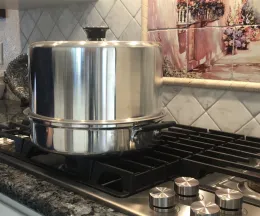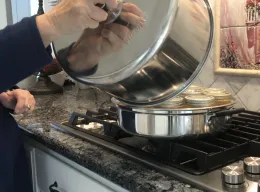By Sherida Phibbs, UCCE Master Food Preserver

The Benefits of Atmospheric Steam Canning vs. Boiling Water Canning
Home food preservation has seen a resurgence in recent years, with many turning to traditional methods to ensure food security and reduce waste. Among the tools available, the atmospheric steam canner has gained attention as a more efficient alternative to the classic boiling water canner—especially for high-acid foods. But what makes it so appealing, and how does it differ from its water-filled counterpart?
What Is an Atmospheric Steam Canner?
An atmospheric steam canner is a shallow pan with a rack and a high-domed lid designed to trap steam. It uses a small amount of water—typically around 2½ quarts—to generate steam that surrounds the jars during processing. This method reaches the same temperature as boiling water (212°F) and is approved for safely processing high-acid foods such as fruits, jams, jellies, pickles, and acidified tomatoes.
Benefits of Using an Atmospheric Steam Canner
- Water Efficiency: Uses significantly less water than a boiling water canner, which typically requires 16 quarts or more.
- Energy Savings: Less water means faster heating and reduced energy consumption.
- Time Efficiency: Reaches processing temperature more quickly, saving 10–30 minutes per batch depending on your stove.
- Kitchen Comfort: Generates less heat, keeping your kitchen cooler during summer canning sessions.
- Ease of Use: Lightweight and easier to handle, fill, and empty compared to heavy water bath canners.
- Safe and Approved: Validated by research from the University of Wisconsin and endorsed by the National Center for Home Food Preservation for high-acid foods.
Important Considerations
- Processing Time: Steam canners are only safe for recipes with processing times of 45 minutes or less due to limited water capacity.
- Altitude Adjustments: Just like boiling water canning, steam canning requires adjustments for elevation.
- Tested Recipes Only: Always use research-based recipes developed for boiling water canning when using a steam canner.
- Ventilation: Ensure a full column of steam is visible before starting the processing time to guarantee proper heat transfer.
Final Thoughts

For those preserving high-acid foods and seeking a more efficient, kitchen-friendly method, the atmospheric steam canner offers a compelling alternative. It’s a modern twist on a time-honored tradition—saving time, energy, and water without compromising safety. Just remember: follow tested recipes, monitor steam flow, and respect the 45-minute limit.
Key Differences: Steam Canner vs. Boiling Water Canner
| Feature | Atmospheric Steam Canner | Boiling Water Canner |
| Water Usage | ~2½ quarts | ~16 quarts |
| Heating Time | Faster | Slower |
| Kitchen Heat | Minimal | High |
| Weight and Handling | Lightweight | Heavier |
| Processing Time Limit | ≤ 45 minutes | No strict limit |
| Suitable Foods | High-acid only | High-acid only |
| Equipment Cost | Requires specific canner | Can use stockpot with rack |
